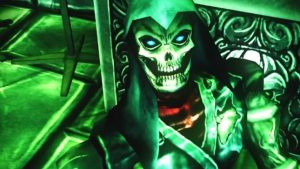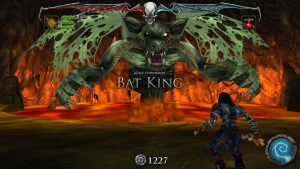Dear Avenged Sevenfold,
Last October, you released The Stage, a concept album about everything from artificial intelligence to space exploration. You did something masterful by fusing some of the most challenging themes of modern times into a single, intricate work of art.
But you did something else, too. By writing The Stage, you also wrote a brilliant video game.
Everyone knows how well you understand the value of video games. You made that clear when you released Hail to the King: Deathbat, a mobile video game based entirely on your music. You took gamers to the depths of hell and showed them what can happen when a game’s entire universe is born from aesthetically rich music.


You owe it to The Stage to turn its music into a video game, because the album’s themes are tailor-made for the medium of video games.
- In “Simulation,” you tackle simulation theory, asking what it would be like if our world were actually just a computer program like The Matrix. What better than a video game’s literally computer-generated world to explore how the Matrix’s “blue pills coat with such disdain,” or how “a subtle breakdown” could jar a literal “code display”?
- In “Paradigm,” you probe the possibility of humans becoming machines through nanotech implants. Video game NPCs are a perfect way to contemplate this robotic future of humanity: they are literally the creations of someone who “architected a code”: they are programs, designed to look and behave like people. What better than a video game’s avatar to “question if these thoughts are mine”? After all, an avatar’s every move in a video game is actually decided by someone else: the player of the video game.
- In “Creating God,” you interrogate the human goal of making a superhuman AI. The world inside a video game is all, in fact, a “simulation” run by a machine. Even if NPCs believe that they are really people able to chart their own destinies, they are really just objects manipulated by the program that is “master of our designs.” All the characters in a video game are trapped in an “artificial dimension” at the mercy of AI, suffering the fate that you explore as a potential future of our real world.
- In “Roman Sky” and “Fermi Paradox,” you embody the unshakeable human desire to explore and understand the entire universe. Video games are the perfect way to represent and explore an entire, dynamic world; imagine the characters of a game trying to understand the entirety of the simulated world they exist in, wondering “how the heavens flow” and “sending the call” to search for other life throughout that world.
- And “Exist” takes on the creation of a universe by representing the Big Bang. That very act—the act of creating a universe—is what happens every time a developer creates the world of a video game.
The Stage evokes themes of mechanized, programmed people trying to understand their simulated, AI-governed universe. These themes are exactly what the artificial, program-driven worlds of video games are best suited to capture in profound, unprecedented ways. That’s why you owe it to your album and to video games to make The Stage a video game.
In case you’re still not convinced, let me go one step further. The Stage isn’t just a perfect fit for a video game because of its themes: its track list also invites a very specific kind of story that would make an amazing video game. I’ll show what a great video game The Stage could make by sketching one possible version of that game’s story, lining it up track-by-track with the eleven songs of The Stage and their lyrics.

- “The Stage.” The game starts not as a video game, but as a movie: we watch a montage of our story’s hero being born (“arriving naked and cold”), growing up (“the boy becoming a man”), and dying (“running out of fight”). Then the game begins, with the faint echo of a voice in the background as our hero dies: “You know this is just a simulation, don’t you?“
- “Paradigm.” Our hero is reborn as the player’s avatar within a video-game world that resembles the world from his old life. As he was about to die, he was given a choice to instead live forever, and he accepted that offer—but he didn’t realize that meant being turned into a video game avatar, with “wires engineered to his brain” so that the player of the game can control him. Our hero doesn’t know this for sure, but he’s suspicious that he’s being controlled in this way: he can’t feel any pain, he can’t really die (the game is reset every time he dies, making him “live forever”), and he occasionally questions if his thoughts and questions are really his—he thinks they’re coming from someone else, controlling him.
- “Sunny Disposition.” This is where the plot really starts: our hero lives in a time of nuclear war—”wars that doom our children to die”—where those in power command armies while slowly destroying the world around them. “Vlader Lauder” is the most powerful, gluttonous, and violent of the world leaders—he’s also the leader of our hero’s country. Our hero decides to enlist as a soldier, with the goal of rising through the ranks and “cutting off Valder Lauder’s head.” He believes that he could save the world if he were only able to rise above his low rank in society: “he’d make a decision if given the privilege, but he’s afraid his taste is unrefined—and no one likes cheap wine.”
- “God Damn.” As our hero rises in the ranks of the military, he recognizes for the first time the full extent of corruption and manipulation in his country. “It goes beyond Big Brother in the sky”: people aren’t just being constantly surveilled; their entire culture has been designed to make them obedient to their government and its kingpin, Valder Lauder. The very idea of God has been instituted by Lauder to lull the commoners into a false sense of freedom—the kind of freedom that “renders them slaves.” The hero realizes that no one else “can see the forest for the trees” because they’re too thoroughly trapped within this culture. He resolves to save them by killing Lauder.
- “Creating God.” The player and hero kill Lauder, only to learn that he isn’t the true enemy: in Lauder’s efforts to completely control everyone, he created a superintelligent AI—a “modern messiah,” “positronic brain”—that took control of the entire world—including Lauder. The hero may have succeeded in cutting off Lauder’s head, but the true enemy remains: the AI has become “master of our designs,” directing the course of human history from the shadows, with the sole goal of extending its own power. By manipulating humans into conducting further AI research, the AI has turned its human “masters” into “stepping stones” for its further growth. The result is that humans are effectively “committing suicide” by fueling the evolution of this AI.
- “Angels.” Our hero, defeated and almost killed by the AI, has a crisis of faith. He’s realized now that he’s spent his life hunting the wrong enemy: he’s been chasing Lauder when he should have been chasing the AI. He “took the road,” pursuing the enemy right in front of him, when he “should have chased the stars,” pursuing the universal AI that had been pulling the strings of all human history in the background. Now, “the faster he runs” from the AI, “the closer the gun” is: the AI is ubiquitous and closing in on him. He asks that the heavens forgive him for his mistakes—that they “wash the devil from his hands”—as he prepares for a final confrontation against the true enemy, the AI.
- “Simulation.” The hero faces off against the AI, only to realize once again that he was chasing the wrong enemy: he realizes that his entire world is nothing more than a simulation, run by a master game designer. How does he realize this? Well, the battle against the AI is incredibly difficult; the player fails many times, causing the hero to die many times and restart the battle many times. Eventually, the hero becomes aware that this cycle of death and restarting is happening: “a subtle breakdown jars the code display,” and he realizes that he is an avatar in a video game, “beaten down time and time again” but always “at the center of it all.” At this point he has a complete mental break, “questioning all the voices in his head,” wondering which of his thoughts are his own, and which are the player’s thoughts. He even tries to resist, making it very hard for the player to control him. Ultimately, the designer that controls the entire simulation ends up “rebooting” the hero to erase his self-awareness: a program called “Blue Comfort” erases his knowledge of the simulation; when he wakes up, he’s back at his home.
- “Higher.” Despite the best efforts of the simulation, the hero ends up remembering over time that he’s trapped in a simulation; he asks for the player’s help in finding a way to free himself from this simulation once and for all. Together, he and the player discover that other people trapped in the game simulation have tried to escape it before: they journeyed to space to try to find and escape the outermost reaches of the simulation, but the AI ultimately destroyed them, drowning their “desperate voices fueled by flames.” The hero decides to follow their lead, journeying into space with the player, “freed of the world,” “hoping” that the people who tried and failed to escape “would send a sign” to try to help him on his path. As he journeys to the depths of space, the spirits of the fallen appear and help him defeat the various obstacles that the AI puts in his path.
- “Roman Sky.” In deep space, in a world near the outermost edge of the simulation, the hero finds the spirit of Giordano Bruno, a man who (in this fiction) was the first to try to escape the simulation, and who learned the entire structure of the simulation even though the AI ultimately killed him. After telling the hero his story, Bruno explains “how the heavens flow,” revealing to the hero and player the hidden path that leads to the game designer controlling the entire simulation.
- “Fermi Paradox.” The hero does faces off against the ultimate, simulation-controlling game designer in a battle against the entire universe, “illustrating his life” by fighting for his freedom “in the void” of deep space. He finally confronts “his sweet Medusa”: the mastermind game designer that paralyzed him by making him into nothing more than a computer program. Back at the start of the game, the designer “reflected the empty in the hero’s being” by turning him from a person into an avatar; now, the hero is taking his humanity back. This final confrontation is also a poetic interpretation of the Fermi paradox itself. The paradox is that it’s highly probable that life other than Earth’s life exists in the universe, yet we don’t see any evidence for other life; the explanation that this part of the game gives for the paradox is that the real extraterrestrial life is the universe itself: it’s not any life inside the universe, but rather the game designer that created and controls the universe.
- “Exist.” After the hero and player defeat the game designer, the simulation dissipates and the hero is freed. With the simulation gone, a new universe begins: like in the beginning, the game becomes a film again; the hero, no longer an avatar, is “beyond the reach of anyone,” with “no hand to hold him.” The game concludes with the hero prepared to live out his own live and then die permanently, saved from the virtual prison of the AI and its game world. Neil deGrasse Tyson‘s monologue about the power of the cosmic perspective plays over the game’s ending credits.
This is just one of many ways to develop the themes of The Stage into a robust and challenging video game, telling the story of a man who will stop at nothing to be free from the systems that control every fiber of his being. This is the kind of art that perfectly mirrors its form with its content, giving gamers an experience that stays with them for years.
The Stage was meant to be a video game, Avenged Sevenfold. We hope you make it happen.




